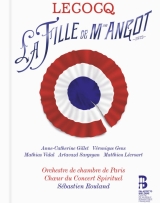Nach einer beschwerlichen Kindheit und Jugend – er war behindert und auf Krücken angewiesen – hatte Charles Lecocq (1832-1918) in einem 1856 von Offenbach ausgeschriebenen Wettbewerb zusammen mit Bizet den ersten Preis für die Operette Le Docteur Miracle errungen. Von da an widmete sich Lecocq dem leichten Genre und komponierte mehr als 50 Operetten und über 100 Lieder. Sein größter Erfolg wurde die Operette La Fille de Madame Angot, die 1872 uraufgeführt wurde.
Die Handlung spielt zur Zeit des postrevolutionären Directoire, also zwischen 1795 und 1799 (dem Jahr, in dem Napoléon das Directoire mit einem Putsch beendete). Clairette Angot (Anne-Catherine Gillet), ein Waisenkind, das von den Bewohnern von Les Halles aufgezogen wird, verliebt sich in den Chansonnier Ange Pitou (Mathias Vidal). Doch nach vielen Liebesabenteuern gibt sie sich damit zufrieden, den Perückenmacher Pomponnet (Artavazd Sargsyan) zu heiraten. Véronique Gens spielt die Rolle der Schauspielerin Mademoiselle Lange.
Die einst sehr populäre Operette wird vom Palazzetto Bru Zane in der Originalversion angeboten. Die Partitur bietet flüssige und gefällige Musik, voller Frische und Finesse.
In der Hauptrolle brilliert die Sopranistin Anne-Catherine Gillet mit einer leichten und koketten Stimme. Véronique Gens überzeugt mit feinstem und ausdrucksvollem Gesang.
Der Tenor Matthias Vidal singt die Rolle des Ange Pitou mit Verve, während Artavazd Sargsyan mit seiner feinen Tenorstimme zwar in der Tiefe etwas Probleme mit der Präsenz hat, aber ansonsten der Rolle des Perückenmachers viel Charme und Frische verleiht.
Die übrigen Rollen sind gut besetzt und der Chor des Concert Spirituel wird seiner in dieser Operette so wichtigen Rolle vollauf gerecht. Das Orchestre de Chambre de Paris, von Sébastien Rouland geleitet, spielt brillant und schwungvoll.
After a difficult childhood and youth – he was disabled and had to rely on crutches – Charles Lecocq (1832-1918) won first prize for the operetta Le Docteur Miracle together with Bizet in a competition launched by Offenbach in 1856. From then on, Lecocq devoted himself to the light genre, composing more than 50 operettas and over 100 songs. His greatest success became the operetta La Fille de Madame Angot, which premiered in 1872.
The plot is set at the time of the post-revolutionary Directoire, that is, between 1795 and 1799 (the year Napoléon ended the Directoire with a coup). Clairette Angot (Anne-Catherine Gillet), an orphan raised by the inhabitants of Les Halles, falls in love with the chansonnier Ange Pitou (Mathias Vidal). But after many love adventures, she settles for marrying the wigmaker Pomponnet (Artavazd Sargsyan). Véronique Gens plays the role of the actress Mademoiselle Lange.
Palazzetto Bru Zane offers the original version of this once very popular operetta. The contains fluid and pleasing music, full of freshness and finesse.
In the leading role, soprano Anne-Catherine Gillet shines with a light and flirtatious voice. Véronique Gens convinces with fine and expressive singing.
Tenor Matthias Vidal sings the role of Ange Pitou with verve, while Artavazd Sargsyan, with his fine tenor voice, has some problems with presence in the depths, but otherwise gives the role of the wigmaker a lot of charm and freshness.
The other roles are well cast and the Concert Spirituel chorus does full justice to its important role. The Orchestre de Chambre de Paris, conducted by Sébastien Rouland, plays brilliantly and with verve.
























